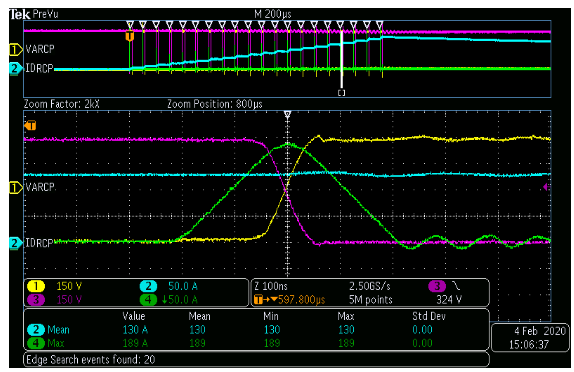One of the core tasks performed by power conversion systems is switching, which is implemented using semiconductor devices like BJTs, thyristors, MOSFETs, and IGBTs. When these devices are turned on or off, the transition time is short, but it is not instantaneous. The time taken to transition between states results in wasted energy, which occurs at the intersection of voltage and current waveforms and is known as switching loss.
The traditional switching approach, known as hard-switching, involves simply forcing the device to turn on and off (commutate) by using the current or voltage signal to directly control the device. In addition to being hard on the device and resulting in switching loss, hard-switching also generates noise in the form of electromagnetic interference (EMI).
A more recent technique, known as soft-switching, was introduced in the 1980s. The idea is to use additional components to implement a resonant circuit that switches when the voltage is zero, thereby minimizing the intersection of the voltage and current waveforms and significancy reducing switching losses and EMI. However, traditional soft-switching forced-resonant circuit topologies have limited adaptability across varying input conditions and load ranges.
Pre-Switch, Inc. has solved the issues of computational limitations, cost, and complexity that previously prevented forced-resonant soft-switching from achieving widespread success. Known as pre-switching, this technology is based on the use of an embedded artificial intelligence (AI) integrated circuit (IC) called Pre-Flex, which precisely controls and adjusts the timing of a very small and low-cost resonant circuit to ensure that there is minimal overlap of current and voltage waveforms of the switching devices.
The Pre-Flex IC learns and adapts in-circuit on a cycle-by-cycle basis to guarantee optimal soft-switching despite any changes in input voltages, output loads, system temperatures, and manufacturing tolerances. In addition to eliminating up to 95% of total switching losses, pre-switching technology also significantly reduces EMI because there is virtually no power radiated during transistor commutation. Furthermore, the technology can be used to enable virtually any desired dV/dt per switching cycle, which is a large enabler for newer, faster-switching, wide-bandgap (WBG) devices.

